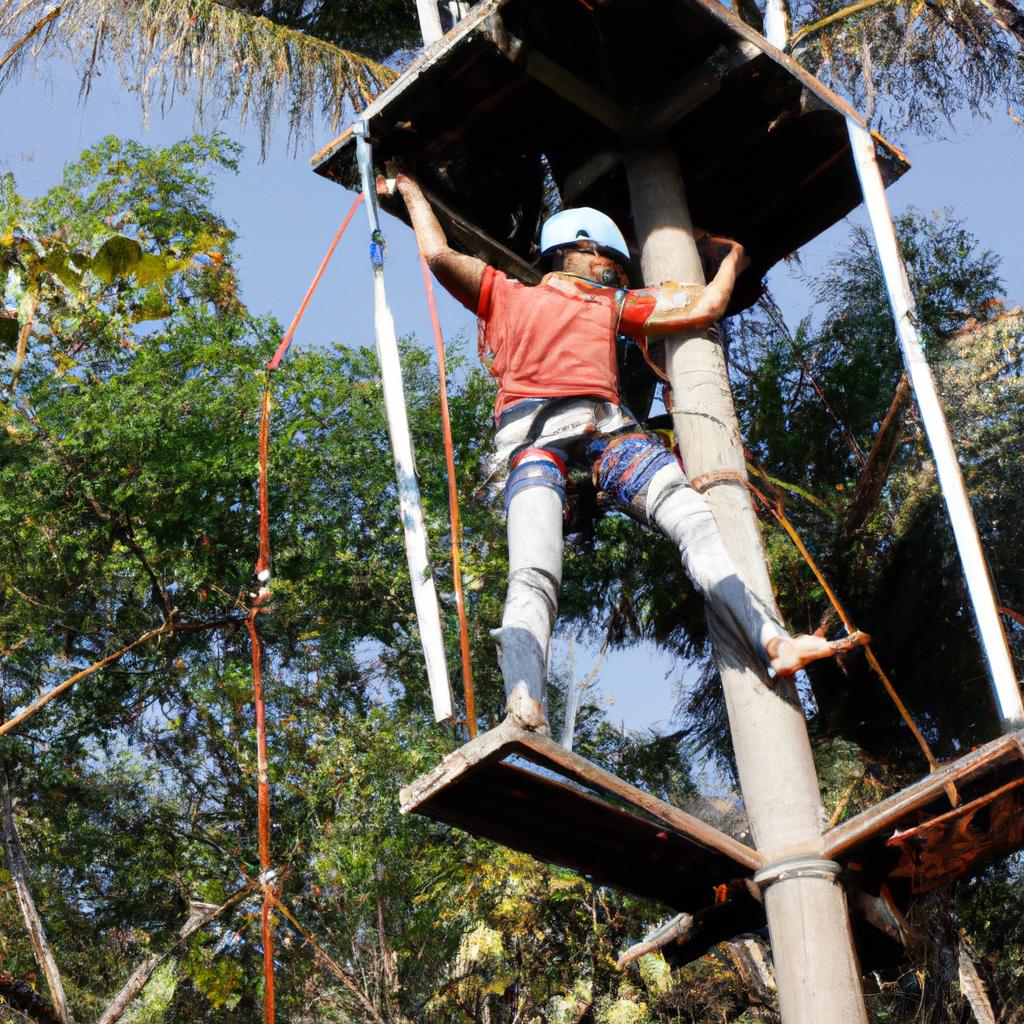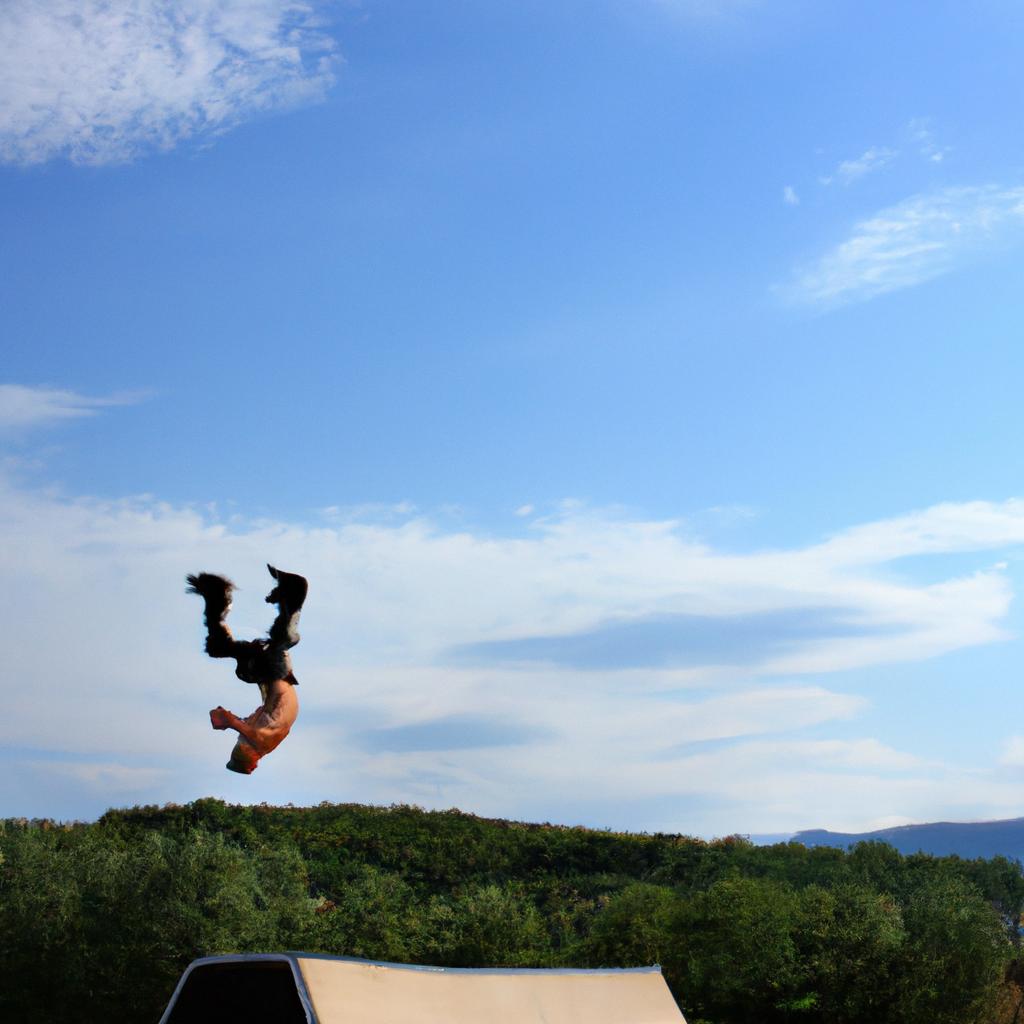National park visits offer families the opportunity to embark on unforgettable vacations surrounded by nature’s breathtaking beauty. These protected areas, often characterized by diverse ecosystems and iconic landscapes, serve as sanctuaries for wildlife and provide a wealth of recreational activities for visitors of all ages. For instance, imagine a family from a bustling city who decides to escape the concrete jungle and explore Yosemite National Park in California. As they drive through winding roads lined with towering sequoias, their excitement grows with each passing mile. They anticipate witnessing the grandeur of Yosemite Valley’s granite cliffs and majestic waterfalls, immersing themselves in an environment that contrasts starkly with their urban surroundings.
National parks have long been recognized as valuable assets for both conservation and recreation purposes. In addition to preserving unique natural features, these protected areas also contribute significantly to local economies through tourism revenue generation. Families can engage in various outdoor activities such as hiking, camping, fishing, and bird watching while being exposed to pristine environments teeming with biodiversity. Moreover, national parks serve as educational resources where children can learn about ecology, geology, and cultural history through interpretive programs offered by park rangers or informative exhibits displayed at visitor centers. Through experiencing these treasures firsthand during family vacations, individuals develop a deeper appreciation for the natural world and a greater understanding of the importance of conservation efforts.
National park visits provide families with an opportunity to disconnect from their busy lives, reconnect with nature, and create lasting memories together. Away from the distractions of technology and everyday responsibilities, families can engage in quality time surrounded by awe-inspiring landscapes. Whether it’s witnessing a bear in its natural habitat or gazing at a star-filled sky away from city lights, these experiences foster a sense of wonder and appreciation for the beauty and complexity of our planet.
Furthermore, national parks offer something for everyone. From easy nature walks suitable for young children to challenging hikes for more adventurous individuals, there are activities to suit all fitness levels and interests. Families can bond over shared outdoor adventures, gaining physical fitness while also developing teamwork and problem-solving skills as they navigate trails and overcome obstacles together.
In addition to recreational opportunities, national parks play a crucial role in environmental conservation. By designating these areas as protected spaces, governments ensure that delicate ecosystems remain intact for future generations. National parks serve as habitats for numerous plant and animal species, some of which may be endangered or threatened. Through responsible tourism practices that prioritize minimal impact on the environment, visitors contribute to preserving these fragile ecosystems.
Ultimately, family vacations to national parks not only provide an escape from daily routines but also instill values of stewardship and environmental consciousness in younger generations. The experience of being immersed in nature’s wonders fosters a sense of responsibility towards protecting our planet’s natural resources. By supporting national parks through visitation and education initiatives, families become advocates for conservation efforts, ensuring that future generations can continue to enjoy these majestic destinations.
Planning a National Park Visit
Imagine a family of four, the Smiths, who are planning their next vacation. They want to embark on an adventure that will not only create lasting memories but also allow them to connect with nature. After much deliberation, they decide to visit one of America’s national parks. Planning a national park visit requires careful consideration and preparation to ensure a smooth and enjoyable experience.
Firstly, it is essential for the Smiths to determine which national park suits their interests and preferences. With over 60 national parks across the United States, each offering unique landscapes and activities, making this decision can be daunting. To assist in their decision-making process, the Smiths should consider factors such as proximity to their location, desired outdoor activities (such as hiking or wildlife spotting), and the time frame available for their trip.
Once the Smiths have chosen their ideal destination, it is important to plan ahead for accommodations and transportation. Many popular national parks have limited lodging options within the park boundaries, often requiring reservations well in advance. Additionally, considering alternative accommodation options outside the park may provide more flexibility while still allowing easy access to explore its wonders.
To further enhance their experience at the national park, the Smiths should prepare themselves with appropriate gear and supplies. A checklist of essentials might include sturdy footwear suitable for hiking trails, weather-appropriate clothing layers, sun protection items like hats and sunscreen, insect repellent, reusable water bottles to stay hydrated throughout their adventures, and snacks or picnic supplies for leisurely breaks amidst breathtaking scenery.
In summary,
- Choosing a suitable national park based on proximity, preferred activities, and available time frames.
- Making early arrangements for accommodations both inside or outside of the park.
- Preparing necessary gear and supplies for comfort during outdoor excursions.
By following these guidelines when planning a national park visit like our hypothetical case study involving the Smiths’ family vacation aspirations comes alive! We’ve explored the first step in their journey, selecting the right national park. Now it’s time to delve into the next stage: Choosing the Right National Park.
Choosing the Right National Park
National Park Visits: Nature’s Beauty on Family Vacations
Planning a National Park Visit:
After carefully considering the various aspects involved in planning a national park visit, it is time to delve into selecting the right national park for your family vacation. Each national park offers unique landscapes, wildlife, and recreational opportunities that cater to different interests and preferences.
Imagine you are seeking a park with stunning waterfalls and abundant hiking trails. Yosemite National Park in California would be an excellent choice. With its iconic landmarks like Half Dome and El Capitan, this renowned park boasts breathtaking views of towering granite cliffs, pristine lakes, and majestic sequoias. Visitors can embark on challenging hikes such as the Mist Trail leading to Vernal Fall or opt for more leisurely walks along meandering paths near Tuolumne Meadows.
To help you make an informed decision when choosing a national park for your family vacation, consider the following factors:
- Proximity: Determine how far you are willing to travel and whether there are any parks within reasonable distance from your location.
- Accessibility: Consider the ease of access to visitor centers, parking facilities, and key attractions within the national park.
- Activities: Assess the range of activities available at each park, such as camping, horseback riding, fishing, boating, or guided nature tours.
- Wildlife: Research which parks offer opportunities for spotting wildlife like bears, moose, elk, or bison – providing memorable encounters with nature.
As you weigh these considerations and narrow down your options based on what suits your family best, consult the table below showcasing some popular national parks’ highlights:
| National Park | Location | Key Attraction |
|---|---|---|
| Yellowstone | Wyoming | Geysers (e.g., Old Faithful), Wildlife |
| Grand Canyon | Arizona | Majestic Canyons |
| Great Smoky Mtns. | Tennessee/N.C. | Scenic Drives, Waterfalls |
| Acadia | Maine | Rocky Coastline, Cadillac Mountain |
By exploring the unique features and attractions of different national parks, you can make an informed decision that aligns with your family’s interests and expectations.
In the subsequent section about “Packing Essentials for a National Park Visit,” we will discuss the key items to bring along on your adventure, ensuring a comfortable and enjoyable experience in the great outdoors.
Packing Essentials for a National Park Visit
When planning a family vacation to a national park, it is crucial to choose the right park that suits your interests and preferences. Let’s consider an example of a family who loves hiking and wildlife spotting. They are looking for a national park where they can indulge in their favorite activities while enjoying nature’s beauty.
One key factor to consider when choosing a national park is its geographical location. Different parks offer unique landscapes and ecosystems, so it is essential to select one that aligns with your interests. For our adventurous family, parks like Yosemite or Rocky Mountain National Park would be great options as they provide breathtaking mountain vistas and extensive trail systems.
Another consideration is the availability of amenities and facilities within the park. While some families prefer camping in remote areas, others may seek more comfort by staying in lodges or cabins. Researching about lodging options, dining facilities, visitor centers, and guided tours offered within the park will help ensure you have all necessary conveniences during your visit.
Additionally, checking if any specific permits or reservations are required for certain activities such as backcountry camping or ranger-led programs is important to avoid any last-minute disappointments. Our family might want to explore Denali National Park in Alaska since it offers opportunities for backcountry camping and chances to spot elusive wildlife like grizzly bears and moose.
To help you remember these considerations easily, here is a bullet point list summarizing them:
- Consider geographical location
- Check availability of amenities and facilities
- Look into permits/reservations needed for specific activities
Considerations when Choosing a National Park
| Geographical Location | Amenities & Facilities | Permits/Reservations |
|---|---|---|
| Unique landscapes | Lodging options | Specific activities |
| Ecosystem diversity | Dining facilities | Backcountry camping |
| Wildlife sightings | Visitor centers | Ranger-led programs |
By carefully considering these factors, you can make an informed decision and choose the right national park that caters to your family’s interests. So let’s now transition into exploring how to pack wisely for a memorable trip amidst nature’s splendor.
Exploring Wildlife in National Parks
Section H2: Exploring Wildlife in National Parks
Having packed all the necessary essentials for a national park visit, it’s time to delve into the fascinating world of wildlife that awaits within these protected areas. One such example is Yosemite National Park, where visitors can witness awe-inspiring encounters with various species of fauna amidst breathtaking natural landscapes.
Paragraph 1:
As families embark on their explorations, they may encounter an array of diverse wildlife species. From majestic elk grazing peacefully in meadows to elusive mountain lions silently prowling through dense forests, each creature contributes to the rich tapestry of biodiversity found in national parks. For instance, at Yellowstone National Park, observing the iconic herds of bison roaming freely across vast plains serves as a profound reminder of nature’s resilience and grandeur.
Bullet Point List (markdown format):
- Witnessing playful otters frolicking in crystal-clear streams
- Spotting bald eagles soaring gracefully above pristine lakes
- Observing black bears foraging for berries in lush mountain valleys
- Listening to the melodic songs of colorful birds echoing through ancient trees
Table (markdown format):
| Species | Habitat | Unique Characteristics |
|---|---|---|
| Elk | Meadows | Large antlers |
| Mountain Lion | Forests | Stealthy hunters |
| Bison | Plains | Massive size |
| Otter | Streams | Aquatic agility |
| Bald Eagle | Lakes | Majestic flight |
| Black Bear | Valleys | Omnivorous diet |
| Colorful Birds | Ancient Trees | Vibrant plumage and melodies |
Paragraph 2:
These remarkable encounters with wildlife not only offer educational opportunities but also evoke a sense of wonder and appreciation for the delicate balance between human existence and the natural world. The chance to witness animals thriving within their natural habitats serves as a poignant reminder of our responsibility to preserve these ecosystems for future generations.
Paragraph 3:
By exploring the vibrant wildlife found in national parks, families can forge unforgettable memories and cultivate a deeper understanding of the interconnectedness of all living beings. As we transition into the next section about “Hiking Trails in National Parks,” let us continue our journey through nature’s wonders, immersing ourselves further in the breathtaking experiences awaiting those who tread upon these paths less traveled.
Hiking Trails in National Parks
Exploring Wildlife in National Parks allows families to engage with nature and observe a wide range of fascinating creatures. For instance, imagine visiting Yellowstone National Park, where you might come across the magnificent American bison roaming freely through vast meadows. These captivating encounters provide not only educational opportunities but also unforgettable memories for families.
To fully appreciate the diverse wildlife found within national parks, it is essential to understand their behaviors and habitats. Here are some key points to consider:
- Variety of Species: National parks serve as sanctuaries for numerous animal species, including mammals, birds, reptiles, and amphibians. The abundance of life forms offers visitors an incredible chance to witness the wonders of biodiversity.
- Environmental Adaptations: Exploring wildlife in national parks provides insight into how animals have adapted to survive in different ecosystems. From bears hibernating during winter months to migratory birds traveling thousands of miles each year, these adaptations showcase the resilience and resourcefulness of Earth’s inhabitants.
- Role in Ecosystems: By observing wildlife interactions firsthand, families can gain a deeper understanding of ecological relationships. Predators hunting their prey or pollinators aiding plant reproduction highlight the interconnectedness between organisms and emphasize the importance of conserving natural environments.
- Conservation Efforts: National parks play a vital role in preserving endangered species and protecting fragile ecosystems. Through responsible tourism practices and support for conservation initiatives, families contribute directly to safeguarding these valuable resources for future generations.
Table: Examples of Wildlife Encounters in Different National Parks
| National Park | Wildlife Encounter |
|---|---|
| Yosemite | Spotting black bears |
| Everglades | Observing alligators |
| Great Smoky | Witnessing synchronous fireflies |
| Glacier | Admiring mountain goats |
Embarking on family vacations in national parks not only creates lasting memories but also fosters a deep appreciation for the natural world. As families venture into these awe-inspiring landscapes, they develop a sense of connection to nature and its inhabitants. The next section will explore another aspect of visiting national parks: capturing beautiful moments that preserve the essence of these remarkable experiences.
Immortalizing the breathtaking beauty of national parks goes beyond simply observing wildlife; it involves capturing unforgettable moments through photography and artistry.
Capturing Beautiful Moments in National Parks
Exploring the Natural Wonders: An Immersive Experience
Imagine standing at the edge of a towering cliff, gazing out into a vast expanse of untouched beauty. The sun casts its warm glow across endless rolling hills and vibrant wildflowers sway gently in the breeze. National parks offer a multitude of unforgettable experiences for families seeking to immerse themselves in nature’s wonders during their vacations. From breathtaking landscapes to unique wildlife encounters, these protected areas provide an opportunity to create lasting memories while fostering a deep appreciation for our natural world.
One example that highlights the transformative power of national park visits is the story of the Johnson family. Seeking an escape from their busy city lives, they embarked on a journey to Yellowstone National Park – known for its mesmerizing geothermal features and diverse wildlife. As they ventured along hiking trails surrounded by steaming hot springs and bubbling mud pots, they were captivated by the stunning scenery that unfolded before them. Witnessing majestic bison roaming freely across vast prairies was an awe-inspiring moment that left them with an indelible sense of wonder.
Visiting national parks can evoke powerful emotions and connections with nature. Here are some reasons why these experiences resonate so deeply:
- Rejuvenation: Surrounded by pristine landscapes, visitors often feel rejuvenated as they breathe in fresh air and soak up the peaceful ambiance.
- Connection: Engaging with nature allows individuals to disconnect from technology and reconnect with each other, creating cherished moments and strengthening familial bonds.
- Discovery: Exploring unfamiliar terrain fosters curiosity and encourages learning about different ecosystems, plants, animals, geological formations, and cultural history.
- Inspiration: National parks inspire people to become stewards of the environment through appreciation for biodiversity conservation efforts.
To further illustrate this point, consider the following table showcasing visitor sentiments after experiencing national parks:
| Emotion | Percentage |
|---|---|
| Awe | 68% |
| Serenity | 52% |
| Gratitude | 46% |
| Amazement | 42% |
In conclusion, national park visits offer families an unparalleled opportunity to immerse themselves in nature’s beauty while creating cherished memories. The Johnson family’s experience at Yellowstone National Park highlights the transformative power of such encounters. From feelings of awe and serenity to gratitude and amazement, these experiences evoke a range of emotions that deepen our connection with the natural world. So pack your bags, lace up your hiking boots, and embark on a journey that will leave you forever changed by the wonders of our national parks.
Sources:
- Visitor Survey Data: National Park Service












